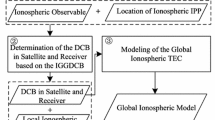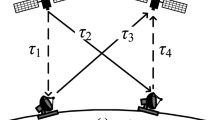Abstract
By expanding the perturbation function of tesseral harmonic \(J_{22}\) term of the earth’s non spherical gravitation, it is found that there is a term \(\cos 2\Omega _{e}\) related to the rotation of the earth. The period of the term is half a day, and the coefficient includes the factor \(\sin ^{2}i\) related to the orbital inclination angle. For the low polar orbit satellite with orbit inclination close to \(90^{\circ }\), \(J_{22}\) term has a great impact on the orbit accuracy, which will reach the order of kilometers. Based on the measured orbit data (historical TLEs and GPS precise ephemeris) of the polar satellite GRACE-A/B, the influence of the tesseral harmonic \(J_{22}\) term on TLE orbit error is further verified. It is found that the system bias caused by ignoring \(J_{22}\) term exists in TLE orbit data for LEO, which shows a periodic change of 180 degrees with the geographic longitude in the in-track direction. In addition, the accuracy of TLE orbit in the northern hemisphere is significantly higher than that in the southern hemisphere, which is related to the distribution of SSN observation network. For GRACE-A satellite, the maximum system bias of TLE orbit can reach close to 1.5 km near the equator of the earth, and 8 km after a 7-day prediction period.

















Similar content being viewed by others
References
Alarcon-Rodriguez, J.R., Martinez-Fadrique, F.M.: Development of a collision risk assessment tool. Adv. Space Res. 34, 1120–1124 (2004)
Bai, X.Z., Chen, L., Tang, G.J.: Periodicity characterization of orbital prediction error and Poisson series fitting. Adv. Space Res. 50, 560–575 (2012)
Bai, X.Z., Chen, L., Tang, G.J.: Explicit expression of collision probability in terms of RSW and NTW components of relative position. Adv. Space Res. 52, 1078–1096 (2013)
Chan, J.C., Navarro, D.: Comparisons of NORAD two-line elements with Intelsat orbit elements. In: Proceedings of the Third European Conference on Space Debris, Darmstadt, Germany, pp. 771–779 (2001)
Fu, Z.Y.: A study for orbit representation and simplified orbit determination methods. Changsha: Central South University of Technology, a thesis submitted for the degree of Master of engineering (2000). http://eprints.qut.edu.au/15895. Cited 03 Dec. 2008
Hoots, F.R., Roehrich, R.L.: Space Track Report No. 3: Models for Propagation of Norad Elements Sets. Aerospace Defense Command, United States Air Force, pp. 1–79 (1980)
Jacco, G., Erwin, M., Ron, N.: TLE uncertainty estimation using robust weighted differencing. Adv. Space Res. 59, 2522–2535 (2017)
Jenkin, A.B., Peterson, G.E.: Collison risk management in geosynchronous orbit. Adv. Space Res. 34, 1188–1192 (2004)
Kaula, W.M.: Theory of Satellite Geodesy. Applications of Satellites to Geodesy. Dover, New York (1966)
Kelso, T.S.: Validation of SGP4 and IS-GPS-200D against GPS precision ephemerides. In: The 17th AAS/AIAA Space Flight Mechanics Conference, Sedona, AZ (2007)
Kelso, T.S.: Analysis of the Iridium 33-Cosmos 2251 Collison. AAS 09-368 (2009)
Lara, M., San-Juan, J.F., López-Ochoa, L.M.: Precise analytical computation of frozen-eccentricity, low Earth orbits in a Tesseral potential. Math. Probl. Eng. 2013, 191384 (2013). https://doi.org/10.1155/2013/191384
Legendre, P., Deguine, B.: Two line element accuracy assessment based on a mixture of Gaussian laws. In: AIAA/AAS Astrodynamics Specialist Conference and Exhibit, Keystone, CO (2006)
Ma, J.B., Liu, L., Wang, X.: Problem about the perturbation due to tesseral harmonic terms in the nonspherical gravitational potential. Acta Astron. Sin. 42(4), 436–443 (2001)
Richard, W.G., Dragan, P.: Impact of non-Gaussian error volumes on conjunction assessment risk analysis. In: AIAA/AAS Astrodynamics Specialist Conference, Minneapolis, MN (2012)
Tapley, B.D., Bettadpur, S., Watkins, M., Reigber, C.: The gravity recovery and climate experiment: mission overview and early results. Geophys. Res. Lett. (2004). https://doi.org/10.1029/2004GL019920
Wang, R.L., Liu, J., Zhang, Q.M.: Propagation errors analysis of TLE data. Adv. Space Res. 43, 1065–1069 (2009)
Xu, X.L., Xiong, Y.Q.: Orbit error characteristic and distribution of TLE using CHAMP orbit data. Astrophys. Space Sci. 36, 31 (2018)
Acknowledgements
This work was supported by the National Natural Science Foundation of China (grant 11473074). The authors would like to thank anonymous reviewer for the valuable comments that helped to improve the manuscript. The author also would like to thank Associate Editor for the valuable suggestions that helped to improve the manuscript.
Author information
Authors and Affiliations
Corresponding author
Additional information
Publisher’s Note
Springer Nature remains neutral with regard to jurisdictional claims in published maps and institutional affiliations.
Appendix 1
Appendix 1
Rights and permissions
About this article
Cite this article
Xu, Xl., Xiong, Yq. The influence of tesseral harmonic \(J_{22}\) term on the TLE orbit error of low polar orbit satellite. Astrophys Space Sci 366, 5 (2021). https://doi.org/10.1007/s10509-020-03916-0
Received:
Accepted:
Published:
DOI: https://doi.org/10.1007/s10509-020-03916-0







